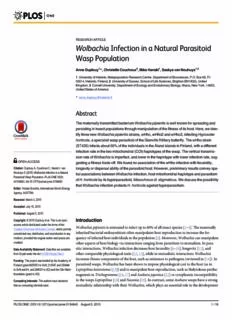
Wolbachia Infection in a Natural Parasitoid Wasp Population PDF
Preview Wolbachia Infection in a Natural Parasitoid Wasp Population
RESEARCHARTICLE Wolbachia Infection in a Natural Parasitoid Wasp Population AnneDuplouy1*,ChristelleCouchoux2,IlkkaHanski1,SaskyavanNouhuys1,3 1 UniversityofHelsinki,MetapopulationResearchCentre,DepartmentofBiosciences,P.O.Box65,FI- 00014,Helsinki,Finland,2 UniversityofSussex,SchoolofLifeSciences,BrightonBN19QG,United Kingdom,3 CornellUniversity,DepartmentofEcologyandEvolutionaryBiology,Ithaca,NewYork,14853, UnitedStatesofAmerica * [email protected] Abstract ThematernallytransmittedbacteriumWolbachiapipientisiswellknownforspreadingand persistingininsectpopulationsthroughmanipulationofthefitnessofitshost.Here,weiden- tifythreenewWolbachiapipientisstrains,wHho,wHho2andwHho3,infectingHyposoter horticola,aspecialistwaspparasitoidoftheGlanvillefritillarybutterfly.ThewHhostrain (ST435)infectsabout50%oftheindividualsintheÅlandislandsinFinland,withadifferent infectionrateinthetwomitochondrial(COI)haplotypesofthewasp.Theverticaltransmis- sionrateofWolbachiaisimperfect,andlowerinthehaplotypewithlowerinfectionrate,sug- OPENACCESS gestingafitnesstrade-off.WefoundnoassociationofthewHhoinfectionwithfecundity, Citation:DuplouyA,CouchouxC,HanskiI,van longevityordispersalabilityoftheparasitoidhost.However,preliminaryresultsconveyspa- NouhuysS(2015)WolbachiaInfectioninaNatural tialassociationsbetweenWolbachiainfection,hostmitochondrialhaplotypeandparasitism ParasitoidWaspPopulation.PLoSONE10(8): ofH.horticolabyitshyperparasitoid,Mesochoruscf.stigmaticus.Wediscussthepossibility e0134843.doi:10.1371/journal.pone.0134843 thatWolbachiainfectionprotectsH.horticolaagainsthyperparasitism. Editor:KostasBourtzis,InternationalAtomicEnergy Agency,AUSTRIA Received:March3,2015 Accepted:July15,2015 Published:August5,2015 Copyright:©2015Duplouyetal.Thisisanopen Introduction accessarticledistributedunderthetermsofthe Wolbachiapipientisisestimatedtoinfectupto60%ofallinsectspecies[1–4].Thematernally CreativeCommonsAttributionLicense,whichpermits inheritedbacterialendosymbiontoftenmanipulateshostreproductiontoincreasethefre- unrestricteduse,distribution,andreproductioninany medium,providedtheoriginalauthorandsourceare quencyofinfectedhostindividualsinthepopulation[5].Moreover,Wolbachiacanmanipulate credited. otheraspectsofhostbiologyviainteractionsrangingfromparasitismtomutualism.Inpara- siticinteractions,Wolbachiainfectiondecreaseshostfecundity[6–10],longevity[11],and DataAvailabilityStatement:Datafilesareavailable fromDryadunderthedoi:10.5061/dryad.34sv3. othercomparablephysiologicaltraits[12,13],whileinmutualisticinteractionsWolbachia increasesfitnesscomponentsofthehost,suchasresistancetopathogens(reviewedin[14]).In Funding:TheprojectwasfundedbytheAcademyof parasitoidwasps,Wolbachiahasbeenshowntoimposephysiologicalcosttothehost(asin Finland(grant#255553toSvN,213547and250444 toSvNandIH,and266021toAD)andtheOttoMalm Leptopilinaheterotoma[15])andtomanipulatehostreproduction,suchasthelytokousparthe- foundation(granttoAD). nogenesisinTrichogramma[16,17]andAsobarajaponica[12]orcytoplasmicincompatibility inthewaspsLeptopilina[18]andNasonia[19].Incontrast,someAsobarawaspshaveastrong CompetingInterests:Theauthorshavedeclared thatnocompetinginterestsexist. mutualisticrelationshipwiththeirWolbachia,whichplaysanessentialroleinthedevelopment PLOSONE|DOI:10.1371/journal.pone.0134843 August5,2015 1/16 WolbachiainHyposoterhorticola ofthehostovaries[20].Inmanycases,exactlyhowWolbachiaaffectshostbiologyandpersists inthehostpopulationisunknown. PrevalenceofWolbachiainfectionvariesfrom100%toextremelylowbetweenhostspecies andamongpopulationswithinahostspecies[21,22].Thisrangeofprevalencecomesabout becausehost-symbiontassociationseitheroccurunderdifferentenvironmentalconditions [23–25];areatdifferentstagesofinfectionhistory[26];orareaffectedbyvariablegeneticfac- torsofeitherthesymbiontorthehost[27,28].Furthermore,throughmanipulationofitshost reproductivesystemWolbachiahavethepotentialtopersistintheirhostpopulationdespite obviouscoststohostfecundity.CIinducing-Wolbachiadothisbycausingtotalorpartial reproductivefailurebetweenmalesandfemaleswithadifferentinfectionstatus,providinga reproductiveadvantagetofemalehosts,whichcanproduceviableoffspringregardlessof whethertheymatewithinfectedoruninfectedmales.Wolbachiathatdistortpopulationsex- ratio(male-killing,parthenogenesisandfeminization)promotetheproductionandfitnessof infectedfemales,ensuringthetransmissionofinfectionthroughgenerations[5].Finally,the coexistenceofinfectedanduninfectedindividualsinapopulationispossibleifthereisperfect verticaltransmissionofthesymbiont[29–32]. IntheÅlandislandsinSouthwestFinland,thepopulationdynamicsoftheGlanvillefritil- larybutterfly,Melitaeacinxia,anditsspecializedparasitoidwasp,Hyposoterhorticola,are closelylinked.Thebutterflylivesasametapopulationinalandscapeconsistingof~4000small habitatpatches(drymeadows),ofwhich500to800areoccupiedyearly.Thehabitatpatches areclusteredinto~100semi-independentnetworks(SINs)[33]withlittlegeneflowofthebut- terflybetweenthenetworks.Incontrast,H.horticolaishighlydispersiveamonglocalbutterfly populationsresultinginhighgeneflowandlowisolationbydistance[34].Hyposoterhorticola isitselfparasitizedbyasimilarlydispersivespecialisthyperparasitoid,Mesochorusc.f.stigmati- cus[35].Ofthethreespecies,H.horticolaistheonlyoneyetfoundtobeinfectedwithWolba- chia(Duplouypers.obs.).Insuchaspatiallyandtrophicallystructuredsystem,Wolbachia epidemiologydependsbothontheeffectsofthebacteriumonthewasphost,aswellasonthe demographyandpopulationdynamicsofitshost. Here,wereportthreenewWolbachiastrains,anddescribeone,wHho,whichispresentin theÅlandislands,atintermediateprevalence.Inanattempttoexplaintheintermediatelevelof infection,wemeasuredtherateofverticaltransmissionandtheassociationofinfectionwith severallife-historytraits.WereportspatialassociationssuggestingthatWolbachiainfection mayinfluencetheresistanceofH.horticolatoitscommonlarvalspecialisthyperparasitoidM. c.f.stigmaticus. MaterialsandMethods Insectmaterial Hyposoterhorticola(Gravenhorst)(Hymenoptera:Ichneumonidae:Campoplaginae)isasoli- taryegg-larvalparasitoidoftheGlanvillefritillarybutterfly,Melitaeacinxia(L.)(Lepidoptera: Nymphalidae)[36].ThewaspparasitizesaboutathirdofthehostcaterpillarsintheÅland islands[37].WeusedH.horticolarearedfromnaturallyparasitizedhostcaterpillarsthatwere systematicallysampledintheÅlandislands(60°07’N,19°54’E)between2008and2013asa partofthelong-termecologicalstudyoftheGlanvillefritillary[33].TodocumentWolbachia infectionoveralongerperiod,wealsoscreenedindividualssampledlesssystematically between1993and2005andpreservedfrozen(-20°C)inethanol.Moreover,toplacethesam- plesinageographicalcontext,weanalysedtheinfectionstatusofH.horticolacollectedfrom Estonia(58°41’N,22°50’E&59°35’N,24°05’E),France(43°61’N,3°87’E),Spain(37°38’N,5° 98’E)andSweden(60°00’N,18°00’E&56°73’N,16°67’E).Altogether751waspswerescreened PLOSONE|DOI:10.1371/journal.pone.0134843 August5,2015 2/16 WolbachiainHyposoterhorticola Table1. WolbachiainfectionrateofthetwomitotypesofHyposoterhorticolainsamplescollected fromFinland,SwedenandEstoniabetween1993and2013(fordetailsseeS1andS2Tables). Population wHho-infected Uninfected C T C T Estonia - - 43 - Finland(Åland) 75 128 185 27 Sweden 9 15 11 - doi:10.1371/journal.pone.0134843.t001 (Table1,S1–S3Tables).Thebutterflyanditsparasitoidarenotclassifiedasthreatenedspecies andhencenopermitsarerequiredfortheircollectioninEurope. WolbachiastrainsandHyposoterhorticolamitotypediversity DNAwasextractedfromthewaspabdomenusingaQiagenDNeasybloodandtissuesextrac- tionkit,followingthemanufacturer’sprotocol(Qiagen,USA).TheDNAqualitywastestedby PCRamplifyingthemitochondrialCOIgene(primerpairLCO/HCO[38]).Anysamplewith noamplificationforCOIwasremoved.TheCOIlocuswassequencedfrom514samples(422, 45,6,6and35fromFinland,Estonia,France,SpainandSweden,respectively,S2Table).Wol- bachiainfectionwasassessedthroughtheamplificationoftwotosevenWolbachialoci,includ- ingthewspgene(primerpair81F/691R[39]),the16S-RNAgene(553F_W/1334R_W[40]) andthefiveMLSTloci(MultiLocusSequenceTypinggenes:CoxA,FbpA,HCpA,GatBand FtSZusingrespectiveprimersfrom[41]).WealsosequencedtwotosevenWolbachialoci (MLST,wspand16sloci)from249(218,5and26fromFinland,FranceandSweden,respec- tively)ofthe340waspsinfectedwithWolbachia.TheFstvalues,basedontheCOIsequences, werecalculatedusingArlequin3[42](S5Table).Eachconsensussequencewassubmittedto GenBank(KF722987–94,KJ150624,KM598264–68&KR185318–21). Phylogenies Phylogenies(Fig1,S1FigandS1File)werebuiltusingtheonlinetree-buildingprogramPhy- logeny.fr[43,44]intheOne-clickmodewithdefaultsettings.ForWolbachia,weusedthe concatenatedwsp,16SandMLSTconsensussequencesfromourthreestrainsandeightaddi- tionalWolbachiastrains(GenBankAM999887,CP001391,CP003883,AE017321,AE017196, EF025179to-183,EF078895,AB474245to-249,AB094382,AB052745).Werootedthetree usingwBmasanoutgroup.ForH.horticolamtDNA,weusedthesevenmitotypesobtained fromoursamplestogetherwithsequencesfromfiveotherspeciesofHyposoter(GenBank JF963449,JQ576453,JQ576979&DQ538855to-58)andtwoCampoletissonorensis(Ichneu- monidae,GenBankDQ538849&-50).WerootedthetreeusingtwoCotesiamelitaearum(Bra- conidae,GenBankKM598269&-70)asoutgroups. MappingoftheinfectionintheÅlandislandpopulation Eachwaspwascollectedfromaknowngeographiclocation,allowingustoanalyseWolbachia prevalenceatthelevelsoflocalbutterflypopulations,semi-independentpatchnetwork(SIN), andinthelandscapeasawhole.Weusedlog-linearmodelstoinvestigatetemporalvariationin prevalencefrom2008until2012inthepooledmaterialfortheÅlandislands(variables:year& infectedversusuninfected)andvariationinprevalenceamongthefiveSINswiththelargest samplesizes(variables:SIN&infectedversusuninfected).Finally,wecomparedinfectionlev- elsbetweenSwedenandtheÅlandislandsusingFisher’sexacttestusingpooleddatafrom PLOSONE|DOI:10.1371/journal.pone.0134843 August5,2015 3/16 WolbachiainHyposoterhorticola Fig1.Rootedphylogrambasedontheconcatenatedsequencesofthewsp,MLST(CoxA,FbpA,FtsZ,GatBandHcpA)and16Sgenesfromnine Wolbachiastrains,includingwHho,andontheconcatenatedsequencesofwspand16SofwHo2andwHho3,withbranchsupportvalues.The wBmstrainfromtheparasiticnematodeBrugiamalayiwasusedasanoutgroup.A,BandDarethreeWolbachiasuper-groups. doi:10.1371/journal.pone.0134843.g001 2008to2012(categoriescomparedwereinfectedanduninfectedindividualsfromSwedenand Finland). Wolbachiatransmissionrate TheverticaltransmissionofWolbachiaisnotalwaysperfect[32].Wemeasuredtheproportion ofWolbachia-infectedprogenyfrom15femalewaspsfromtheÅlandislands,eightinfected andsevenuninfected.Eachfemaleparasitizedabutterflyhostegg-clutchinthelaboratory(see [45]formethods).Thecaterpillarswerereareduntilthe4thinstar(15caterpillarsperfemale) oruntilwaspsemergedasadults.Wedetectedparasitisminthe4thinstarcaterpillarsbyampli- fyingboththeparasitoidwaspDNA(microsatelliteregionHho10[46])andasectionofthe repeatelementprotein-b11fromthewasp-integratedichnovirus(length:429bp,PCRanneal- ingtemperature:50°C,primers:34F5’-GGCGTATGCARTAGTGRTGAAand463R5’-GAT TATCGGAACCTGRTYGAA,thisarticle).Additionally,becausemostH.horticolaemerging fromthesamefamilygroupofGlanvillefritillarylarvaearefullsiblings[47],weestimated transmissionrateinalargersampleusingtheinfectionstatusofwaspsemergingfromsamples oftwoorthreehostindividualtakenfromeachof51hostfamilygroupsduringthefieldsurvey (S4Table).Therateoftransmissionassociatedwiththetwowaspmitotypeswascompared usingaFisher’sexacttest. Hyposoterhorticolasexratio Insomesystems,Wolbachiaskewsthesexratioofthehostpopulationtowardfemales (throughkillingorfeminizationofmales,orviaparthenogenesis)[5].Aseachparasitized M.cinxialarvalgroupcontainsprimarilyoffspringofasingleH.horticolafemale[47],we PLOSONE|DOI:10.1371/journal.pone.0134843 August5,2015 4/16 WolbachiainHyposoterhorticola determinedtheper-motherallocationtomaleandfemaleprogeny,andthepopulation-level sexratio,byrecordingthesexofeachindividualrearedfrom53larvalgroupsparasitizednatu- rallyintheÅlandislandsbetween2007and2010.Theirinfection-statusisnotknown.How- everyearlyrandomcollectionsshowthathalfofallcollectedwaspscarrywHhointheÅland islands(S1Table),soweassumethataroundhalfofthese53larvalgroupsoriginatefrom infectedwasps.Themeanbroodsexratio(fractionmale)wascomparedwithanequal(0.5)sex ratiousingt-test.Thedistributionofbroodsexratioswascomparedwithanormaldistribution usingtheShapiro-Wilkgoodnessoffittest. Hyposoterhorticolaegg-load Wolbachiaisknowntoaffecthostfecundity[7,9].Wetestedforanassociationbetweenthe infectionstatusandegg-load(asproxyforfecundity)of213females(including111infected and102uninfected)rangingfromage0(dayofemergence)to51days(maximumlifespanin thelaboratory).Thewaspswererearedfromnaturallyparasitizedcaterpillarsandrandomly killedatdifferentages,yieldingasimilarsampleofinfectedanduninfectedindividualsateach agepoint.Theovariesweredissectedinsterileconditionsandmatureeggsintheoviductand calyxorganswerecountedaspartofanotherstudy[45].Theinfectionstatusofeachwaspwas determinedupondeath.Theeggloadwasthenanalysedusingalinearmodel,withtheinfec- tionstatusandageofthewaspasexplanatoryvariables. Hyposoterhorticolalongevity PresenceofWolbachiacandecreasehostlongevity[11].Fifteenfemalesand33males,reared underlaboratoryconditionsfromcaterpillarsnaturallyparasitizedintheÅlandislandsin2010 and2011,werekeptinindividualvials(V=100ml)inanincubatorat12:12L/Dand18/10°C day/nighttemperature.Waspswerefed30%honeysolutioneveryotherdayuntilnaturaldeath (asdescribedin[45]),andlaterassessedforWolbachiainfection.Wetestedtheassociationof longevitywithinfectionstatususingalinearmodel,withsexincludedasanextraexplanatory variable. AssociationofWolbachiainfectionwithhabitatconnectivity IfWolbachiainfectiondecreasesdispersalabilityofwasps,wewouldexpectlowprevalenceof thebacteriumwherelocalbutterflypopulationsaresparseinthelandscape(lowconnectivity) [48],asthechancesforWolbachia-infectedwaspstoreachthesurroundinghabitatpatches wouldbereduced.Alternatively,ifthebacteriumincreaseddispersalability[49],wemight expectprevalencetobelowerinhighlyconnectedhabitatpatches.Foreachyear(2008–2013), wecalculatedanindexofconnectivityofeachlocalbutterflypopulationfromwhichwasps werereared,accountingforthedistancefromeachlocalbutterflypopulationtoallotherpopu- lations,thesizesofthepopulationsandthedispersalabilityofthebutterfly[50,51].Usinga linearmodelwetestedpossibleassociationoftheinfectionrateofH.horticolainalocalbutter- flypopulationinyeartwiththeconnectivityofthepopulationinyeart-1,aswaspscollectedin thecurrentyearweretheprogenyofadultsfromtheprevioussummer. Wolbachiainfectionandhostmetabolicrate Wolbachiacaninfluencebasicphysiologicalandmetabolicfunctionsofitshost.Thiswouldbe especiallyrelevantforthedispersalabilityofthewasp,asflightismetabolicallyexpensive[52, 53].Wecomparedtheactiveandrestingmetabolicrates(AMRandRMR,respectively)of33 Wolbachia-infectedand29uninfectedwaspsrearedfromcaterpillarscollectedfromthewild PLOSONE|DOI:10.1371/journal.pone.0134843 August5,2015 5/16 WolbachiainHyposoterhorticola in2013.Themetabolicratesweremeasuredusingflow-throughrespirometryattheconstant temperatureof30°C[53].TheAMRwasmeasuredasthemaximumrateofCO emission 2 underabrightlightduring7minofforcedactivityinducedbyflickingthe100mlmetabolic chambereachtimethewasp’swingswerestill(H.horticolamayflyformorethan30minwith- outexhaustion,Duplouy,pers.obs.).WeusedtheaverageCO emissionrateduring60secpre- 2 cedingtheactiveperiod,underacovertoblocklight,asameasureoftheofthebaselineRMR. MeasuresofAMRandRMRwerecorrectedforvariationinbodymassbyusingresidualsfrom linearregressionbetweenthemetabolicrateandtheweight.Linearmodelswereusedtoana- lyseassociationsofCO emissionratewiththeinfectionstatusandsexofindividuals. 2 PrevalenceofWolbachiaandtherateofhyperparasitism IfWolbachiaconfersresistanceagainstparasitoids,wemightexpectthebacterialinfectionto behighwheretheriskofparasitismishigh[54].Weusedlinearregressiontocomparethe prevalenceofWolbachiainfectioninH.horticolaandtherateofhyperparasitismbyMeso- chorusc.f.stigmaticususingdatafromtensemi-independentpatchnetworks(SINs)inthe Ålandislands.ForeachSIN,wecalculatedtherelativeabundanceofthehyperparasitoidas thenumberofhyperparasitoidsinthesampledividedbythesumoftheparasitoidsand hyperparasitoids. Dataaccessandanalysessoftware DatafilesareavailableinDryadunderthedoi:10.5061/dryad.34sv3.Statisticalanalyseswere performedusingR64[55]. Results WolbachiainfectioninHyposoterhorticola TheFinnishandSwedishpopulationsofH.horticolacarryacommonWolbachiastrainthat belongstotheWolbachiaB-supergroup(Fig1),andwhichwenamewHho(ST435).Asingle specimenfromtheÅlandislands(sampledin1998)wasinfectedbyanA-supergroupstrain, wHho3.SamplesfromEstonia(n=43)andSpain(n=6)wereuninfected,whilesamplesfrom France(n=6)carriedathirdstrain,calledwHho2,alsointheA-supergroup. IntheÅlandislandsandSweden,Wolbachiainfectionrateisrelatedtothemitochondrial haplotype(mitotype)ofthehost.BasedontheCOIsequence,therearetwocommonmito- types,whichdifferbyasinglebasepairsubstitution(synonymoussubstitutionbetweenCand Tatthenucleotideposition364,thecodonencodingforLeucineatposition121).Individuals withmitotypeTaremorelikelytobeinfectedbyWolbachiathanindividualswithmitotypeC (Åland:87%vs.30%;Sweden:100%vs.56%,Fisher’sexacttestsP=0.0001andP=0.0068, respectively,Fig2).TheoverallinfectionrateissignificantlyhigherinsamplesfromSweden thanfromtheÅlandislands(P=0.012).WithintheÅlandislands,fromwherewehavesam- plesfrom2008until2013,theoverallinfectionratehasremainedstable(non-significantinter- actionbetweenyearandinfectionrate,df=4,P=0.21).However,therearehighlysignificant differencesintheinfectionratebetweenSINs(df=16,P<0.001,Fig2),andtheoverallinfec- tionrateiscorrelatedwiththefrequenciesofthetwomitotypes(df=1,P=0.039,Fig3). Transmissionrate Ofthefifteenfemalewaspsusedinthetransmissionexperiment,eightwereinfectedby Wolbachia.FiveoftheeightshowedhighWolbachiatransmission(>85%),whiletheremain- ingthreeshowedlowertransmission(between33and66%).Noneoftheoffspringoftheseven PLOSONE|DOI:10.1371/journal.pone.0134843 August5,2015 6/16 WolbachiainHyposoterhorticola Fig2.GeographicalpatternofWolbachiainfectionrate(ingrey)insamplesatthe(A)regionalscaleinFinland,SwedenandEstonia,and(B) amongnetworksofhabitatpatchesintheÅlandislandsinFinland.Thedataincludessamplescollectedbetween2008and2013.Largecirclesshow theinfectionrateintheTmitotypeandsmallcirclesintheCmitotype.Whenonemitotypeisabsent,therespectivecircleisalsoabsent(e.g.onlytheC mitotypeoccursinEstonia). doi:10.1371/journal.pone.0134843.g002 uninfectedmotherswereinfected(S4Table).Asonlyoneoftheeightinfectedfemaleshad mitotypeC,thismaterialcannotbeusedonitsowntocomparethetwomitotypes.Wethere- foreaugmentedthelab-rearedmaterialwiththefield-collectedsamples.Amongthepresumed Fig3.RelationshipsbetweenHyposoterhorticolamitotype,WolbachiainfectionandhyperparasitismbyMesochorusc.f.stigmaticusin10sub- regionsintheÅlandislands.Thedatawerecollectedfrom2008to2013.Panel(A)showstheassociationbetweenWolbachiainfectionrateandthe relativeabundanceoftheTmitotypeinH.horticola(P=0.01).Thenexttwopanelsshowtherelationshipsbetweentherelativeabundanceofthe hyperparasitoidand(B)therelativeabundanceoftheTmitotype(P=0.039)and(C)Wolbachiainfectionrate(P=0.11). doi:10.1371/journal.pone.0134843.g003 PLOSONE|DOI:10.1371/journal.pone.0134843 August5,2015 7/16 WolbachiainHyposoterhorticola siblinggroupsproducedbyaninfectedindividualoftheCmitotype,nineoutof17(53%) includedoneuninfectedoffspring(twotosevenoffspringpermother).Incontrast,amongthe presumedsiblingsgroupsfrominfectedfemaleswithmitotypeT,onlyfiveoutof30(17%)sib- linggroupshadatleastoneuninfectedindividual.Theseresultssuggestthattransmissionis lessefficientintheCmitotype(Fisher’sexacttest,P=0.018).Theabsolutevaluesofuninfected individualsarelikelytobebiased,assomeinfectedfemalesofeithermitotypemayhavehad onlyuninfectedoffspring,andhencethefemalewaswronglyscoredasuninfected.However, comparisonofthetwomitotypessuggestsmoreefficienttransmissionintheTmitotype. Life-historyandfitnessconsequencesofWolbachiainfection IntheÅlandislands,H.horticolahasanequalpopulation-levelsexratio(0.54,SD=0.24), whichdoesnotdifferfrom0.5(t=1.01,P>0.05).Moreover,thebroodlevelsexratiowasnor- mallydistributedaroundthemeaninwaspsfrom53hostlarvalfamilygroups(Shapiro-Wilk Goodness-of-fittest,W=0.9827,P=0.78).Thereisthusnoevidenceforextremesexratiodis- tortion.However,theseresultsdonotruleoutthepossibilityofotherreproductivemanipula- tionsapartfromsexratiodistortion,suchasCI. WefoundnoassociationofWolbachiainfectionwithfitness-relatedtraitsinH.horticola. Infectedanduninfectedfemaleshadsimilaregg-load(520and522,df=1,P>0.05,Fig4). Femaleslivedlongerthanmales(37versus31days,df=1,P=0.036),andWolbachiainfection wasunrelatedtolongevityineithersex(df=1,P>0.05,S2Fig). WefoundnoassociationofWolbachiainfectionwithhabitatconnectivityintheprevious year(FigAinS2File),suggestingthattheinfectiondoesnotinfluencewaspmobility.Consis- tentwiththisnegativeresult,therewasnoassociationofWolbachiainfectionwithactiveor restingmetabolicrate(FigsBandCinS2File). Fig4.Theegg-loadoffemalewaspsfromtheÅlandislandsinrelationtotheirageandwhethertheyareinfectedbyWolbachia(triangles,n=111) ornot(circles,n=102). doi:10.1371/journal.pone.0134843.g004 PLOSONE|DOI:10.1371/journal.pone.0134843 August5,2015 8/16 WolbachiainHyposoterhorticola Parasitoid-hyperparasitoidinteractionandWolbachiainfection WeanalysedtherelativeabundancesofH.horticolaanditshyperparasitoidMesochorusc.f. stigmaticus,aswellasWolbachiainfectionrate,intenregionsintheÅlandislands(Fig2B). ThehyperparasitoidhadgreaterrelativeabundancewheretheprevalenceofthehostTmito- typewaslower(P=0.039).RecallingthatWolbachiainfectionrateishigheramongT-than C-mitotypewasps(above),thisresultsuggeststhehypothesisthatwHhoinfectionprotects H.horticolaagainstthehyperparasitoid.Indeed,inthesedataWolbachiainfectionrateislow wherehyperparasitismishigh,thoughtheassociationisnotstatisticallysignificant(P=0.11, Fig3C).InEstonia,whereWolbachiaisentirelyabsent,allthewaspsareofmitotypeCandthe hyperparasitoidisabsent.UnderthehypothesisthatWolbachiaprotectsagainsthyperparasit- ism,wewouldexpectWolbachiatobeabsentwherethereisnohyperparasitoidbecause,asit wouldbenoadvantagetoitshost,itwouldnotspread. Discussion WedescribethreeWolbachiastrainsintheichneumonidwaspHyposoterhorticola,aparasit- oidoftheGlanvillefritillarybutterfly:twoA-groupstrains,wHho2andwHho3,detected fromFrenchsamplesandauniqueFinnishsample,respectively,andaB-groupstrain,wHho (ST435),whichiswidespreadintheÅlandislandsinFinlandandinSweden.NoWolbachia wasidentifiedinsamplesfromEstonia(n=47).ThehostH.horticolahassevenCOImitotypes inourmaterial,ofwhichthetwocommonones(mitotypesCandT)occurinFinlandandSwe- den,oneraremitotypeoccursinEstonia,andfourotherdivergentmitotypescamefromFrance andSpain.Thepost-glacialrangeexpansionofH.horticolaisunclear,butitmayhavespread tonorthernEurope,possiblywithdifferentWolbachiastrains,frombothAsianandsouthern Europeanrefugia,ashasitshostbutterfly[56]andanotherspecialistparasitoidCotesiameli- taearum[57]. RateoftransmissionandassociationofWolbachiainfectionwithhost mitotype WefoundthatintheÅlandislandstherateofverticaltransmissionofWolbachiaisimperfect, suggestingthattheinfectionpersistsinanintermediatestate,inbalancebetweenfitnessbene- fitsandcosts[58,59].Moreover,thetwoH.horticolamitotypesarenotequallyinfected.Inthe FinnishandSwedishpopulations,WolbachiaiscommoninthehostmitotypeT(92%)but muchlesscommonintheCmitotype(43%).InEstonia,allwaspshadtheCmitotypeand wereuninfected. BothmitochondriaandWolbachiaaretransmittedmaternally.HencepatternsofmtDNA- Wolbachiaassociationreflectinfectionbiogeography,strengthoftransmission,andhistoryof Wolbachiaspreadinhostpopulations[60,61].Whenverticaltransmissionisefficient,Wolba- chiainfectionmayresultinaselectivesweepleadingtodistinctinfectedanduninfectedmatri- lines([26,62]e.g.inbutterflies[63]andfigwasps[64]).Whentransmissionisimperfector whenthereishorizontaltransfer,infectedanduninfectedindividualsmaysharethesame mitotypes[65].InfectionrateofthewHhostraininFinlandandSwedenmaybehigherinthe TthantheCmitotypebecausewHhoinfectedthecommonancestralmatrilineofbothmito- types,buttransmissionrateishigherintheTmitotype.Alternatively,thewHhostrainmay havefirstarisenintheTmitotypeandlatercolonizedtheCmitotypebylateraltransfer.Such lateraltransmissioncouldoccuriftwoindividualsparasitizethesamehost(superparasitism), whichcanoccasionallyhappeninH.horticola[37].AlternativelythehyperparasitoidM.c.f. stigmaticuscouldtransmitthebacteriumbetweenhosts(e.g.inaphids[66]).Finally,itisalso PLOSONE|DOI:10.1371/journal.pone.0134843 August5,2015 9/16 WolbachiainHyposoterhorticola possiblethatthemitotypediversityishigherthanwhattheCOIgenealoneindicates,which wouldincreasethecomplexityofthesystem. Wolbachiainfectionandhostfitness Wolbachiaisknowntoinfluencehostfitness,reproductivesystemandbehaviourtoimprove itstransmission[67].InthisstudytheprevalenceofwHhodifferedgeographicallybetweenthe studyregions,from0to74%,atthescaleofseveralhundredkm(Fig2A),aswellasatasmaller spatialscalewithintheÅlandislands,whereinfectionratevariesfrom8to100%regionally (Fig2B).Withefficienttransmission,asappearstohappenintheTmitotype,thebacterium wouldneedtoenhancehostfitnessonlylittle,ortoinduceastrongCI,topersist.IntheC mitotypewithlessefficientverticaltransmission,thefitnessbenefitwouldneedtobegreaterto compensateforthelowertransmissionrate. Modelspredictthathighvariationinprevalenceamongpopulationsmayoccurwhenthere ishighspatialpopulationdynamics[59,68].EnvironmentalheterogeneityintheÅlandislands leadingtolargevariationandfluctuationoflocalhostpopulationsizes[69]andprevalenceof thehyperparasitoidM.c.f.stigmaticus[35],mayinteractwiththeeffectsofWolbachiaonits host,leadingtospatialvariationinprevalence. Longevityandfecundityarecorrelatedwithfitnessinparasitoids[70],andareoftenaffected byWolbachia[15,71].Wolbachiainfectioncanalsoinfluencebehaviouraltraits,suchasdis- persalinmosquitos[49].However,wefoundnoevidenceforwHhoinfluencinghostwasplon- gevity,fecundityordispersalinthefield.Thelackofanassociationofinfectionwithlife historyorbehavioursuggeststhatthepatternofWolbachiainfectionintheÅlandislandsmay simplybeinatransitionalstate,onitswaytowardfixationorextinction(e.g.inbutterflies [26]).However,thespreadofaCI-inducingorabeneficialstraincouldalsoshowsuchhetero- geneitybetweenlocalpopulations[72,73]. Alternatively,Wolbachiamayhavealesscommonlystudiedassociationwithfitness.One interestinghypothesis,suggestedbyourresults,isthatWolbachiaconfersresistancetohyper- parasitism.Severalsymbionts,includingWolbachia([74]butsee[75,76])havebeenfoundto protecttheirhostsagainstparasitoids(e.g.inaphids[77,78]andfruitflies[79]).Thespecialist hyperparasitoidM.c.f.stigmaticusisubiquitousintheÅlandislandsandSweden[35],where Wolbachiaprevalenceisgreaterthan50%,whileM.c.f.stigmaticusisabsentfromEstonia[37], whereWolbachiaisalsoabsent.Furthermore,withintheÅlandislands,therelativeabundance ofthehyperparasitoiddecreasedwithincreasingprevalenceofthehostTmitotype.AstheT mitotypeisalsomoreoftenassociatedwithWolbachiathantheCmitotype,wesuggestthat thepresenceofWolbachiamayimproveresistancetohyperparasitism.Thus,wHhocouldbe maintainedbecausetheinfectionreducesthelikelihoodofsuccessfulhyperparasitism. Toconclude,inthiscomprehensivelandscape-levelstudyofWolbachiaprevalenceina largespatiallystructuredwasppopulation,thereisastableintermediateWolbachiainfection rate,whichissignificantlydifferentintwohostmitochondrialhaplotypes(mitotypes).This patternhasseveralpossibleexplanations,includingimperfectbutdissimilarverticaltransmis- sionrateinthetwomitotypes.Second,wefoundnodirecteffectofinfection,positiveornega- tive,onfitness-relatedtraitsofthehost,includingegg-load(fecundity),adultlongevity, metabolicrateandameasurereflectingdispersalrateinthefield.Third,wehavenoevidence ofsex-ratiodistortioninthehost,thoughwecannotruleouttheexpressionofCIanditsconse- quencesforthespreadofthebacteriuminthepopulation.Thelackofapositiveassociation withhostfitnessmayindicatethatWolbachiaisinatransitionalstateinthelandscape,orthat itismaintainedviasomeothermechanism.Onesuchmechanismisprotectionagainsthyper- parasitism.Wedonothavedirectexperimentalevidenceforthishypothesis,butitissupported PLOSONE|DOI:10.1371/journal.pone.0134843 August5,2015 10/16
Description: